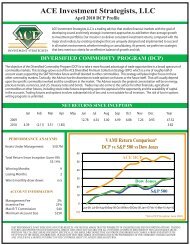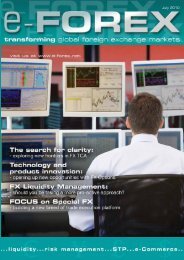You also want an ePaper? Increase the reach of your titles
YUMPU automatically turns print PDFs into web optimized ePapers that Google loves.
ALGORITHMIC FX TRADING<br />
In terms of how algorithms can help FX trading firms<br />
meet their different execution timeframe and visibility<br />
preferences, Horowitz says he is seeing much more<br />
use of 'synthetic' algorithms that can only be executed<br />
over an FX aggregating platform, such as synthetic<br />
icebergs. "We also see that traders prefer not to watch<br />
orders as much as algorithms. They want to make a<br />
decision, fire off an algorithm and be alerted when it<br />
trades or other changes happen. It's much easier to<br />
deal with algorithms than orders. Algorithms remove<br />
a lot of the manual drudgery, so traders can focus on<br />
the goal, and less so the mechanics." Horowitz adds<br />
to really understand the phenomenon of advanced FX<br />
algorithms being deployed by major sell-side banks<br />
and broker dealers one should speak with several of<br />
Aegisoft's premier customers such as Citi, which has<br />
its Silent Partner and Ripple Algorithms.<br />
One recent phenomenon in the world of FX<br />
algorithms has been the development work taking place<br />
at the major sell-side banks and broker dealers.<br />
According to Mark Sykes, director, Foreign Exchange<br />
at Citi, we are now seeing second and third generation<br />
algorithms that are able to operate opportunistically so<br />
as to more efficiently match implementation strategies<br />
with the investment objectives of the users.<br />
“The primary objective of the execution strategy is<br />
always to ensure that the balance of the speed of<br />
execution versus the risks of showing the flow to the<br />
84 | january 2010 e-FOREX<br />
>>><br />
external market is perfectly balanced,” says Sykes.<br />
“Attempts to get an execution done faster inevitably<br />
lead to adverse price movements as your intentions<br />
be<strong>com</strong>e exposed; this is particularly true of more<br />
illiquid currency pairs in the emerging market space<br />
which demonstrate a very high signal to noise ratio in<br />
their price action. Second and third generation<br />
execution algorithms have had immense amounts of<br />
intellectual capital embedded within them, massive<br />
investments in quantitative analysis, all with the aim<br />
of ensuring that this balance is perfectly achieved.<br />
Looking forward, I would expect more sophistication<br />
in this area, particularly in the way that short term<br />
price and flow patterns are recognised by the<br />
execution algos, and subsequently acted upon.”<br />
As with any market innovation, says Sykes, some<br />
speculators will attempt to use it to their advantage in<br />
order to generate alpha and FX algorithms are no<br />
different. “For every execution methodology, be it by<br />
a manual spot trader or a black box, there are many,<br />
many systemic trading houses monitoring market<br />
data, attempting to detect patterns, and subsequently<br />
act upon them. The easiest flow to detect and<br />
monetise is of course that of the manual trader.<br />
Throughout history, mankind has demonstrated a<br />
wonderful disregard for history and simply repeated<br />
the same mistakes time after time. This trait is the<br />
mainstay of algorithmic houses,” says Sykes.<br />
James Dalton<br />
“As a general rule the more aggressive strategies will suit the<br />
active intra-day traders and the passive strategies are more<br />
about providing ‘best execution’ to those who look to enter<br />
positions that are held for a day or longer.”










